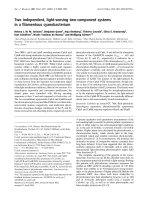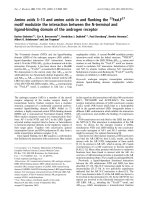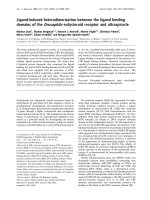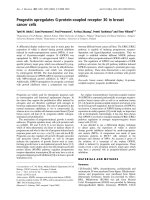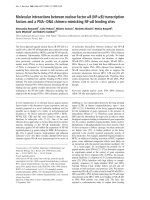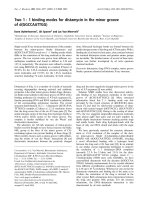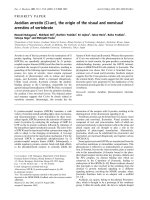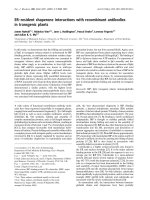Báo cáo y học: " Enhanced protein-energy provision via the enteral route in critically ill patients: a single center feasibility trial of the PEP uP protoco" ppsx
Bạn đang xem bản rút gọn của tài liệu. Xem và tải ngay bản đầy đủ của tài liệu tại đây (592.37 KB, 12 trang )
Heyland et al. Critical Care 2010, 14:R78
/>Open Access
RESEARCH
BioMed Central
© 2010 Heyland et al.; licensee BioMed Central Ltd. This is an open access article distributed under the terms of the Creative Commons
Attribution License ( which permits unrestricted use, distribution, and reproduction in
any medium, provided the original work is properly cited.
Research
Enhanced protein-energy provision via the enteral
route in critically ill patients: a single center
feasibility trial of the PEP uP protocol
Daren K Heyland*
1,2,3
, Naomi E Cahill
2,3
, Rupinder Dhaliwal
3
, Miao Wang
3
, Andrew G Day
3
, Ahmed Alenzi
1
, Fiona Aris
4
,
John Muscedere
1
, John W Drover
5
and Stephen A McClave
6
Abstract
Introduction: The purpose of this pilot study is to assess the feasibility, acceptability, and safety of a new feeding
protocol designed to enhance the delivery of enteral nutrition (EN).
Methods: In a prospective before and after study, we evaluated a new protocol compared to our standard feeding
protocol. Innovative elements of the new protocol included setting daily volume based goals instead of hourly rate
targets, initiating motility agents and protein supplements on Day 1, liberalizing the gastric residual volume threshold,
and the option to use trophic feeds. Bedside nurses filled out questionnaires to assess the acceptability of the new
approach and we assessed patients' nutritional and clinical outcomes.
Results: We enrolled 20 mechanically ventilated patients who stayed in the Intensive Care Unit for more than three
days in the before group and 30 such patients in the after group. On a scale where 1 = totally unacceptable and 10 =
totally acceptable, 30 nurses rated the new protocol as 7.1 (range 1 to 10) and no incidents compromising patient
safety were observed. In the before group, on average, patients received 58.8% of their energy and 61.2% of their
protein requirements by EN compared to 67.9% and 73.6% in the after group (P = 0.33 and 0.13). When the subgroup of
patients prescribed to receive full volume feeds in the after group were evaluated (n = 18), they received 83.2% and
89.4% of their energy and protein requirements by EN respectively (P = 0.02 for energy and 0.002 for protein compared
to the before group). The rates of vomiting, regurgitation, aspiration, and pneumonia were similar between the two
groups.
Conclusions: This new feeding protocol seems to be safe and acceptable to critical care nurses. The adoption of this
protocol may be associated with enhanced delivery of EN but further trials are warranted to evaluate its effect on
nutritional and clinical endpoints.
Trial registration: ClinicalTrials.gov NCT01102348
Introduction
Several observational studies have described an associa-
tion between inadequate feeding and poor clinical out-
comes in critically ill patients [1-3]. In a multicenter
observational study of 2,772 Intensive Care Unit (ICU)
patients from 165 ICUs, Alberda and colleagues showed a
significant inverse linear relationship between the odds of
mortality and total daily calories received [4]. An increase
of 1,000 calories per day was associated with reduced
mortality (Odds Ratio for 60-day mortality 0.76 (95%
Confidence Intervals (CI) 0.61 to 0.95, P = 0.014)) and an
increased number of ventilator-free days (VFDs) (3.5
VFD, 95% CI, 1.2 to 5.9, P = 0.003). Since the main route
of providing energy and calories was enteral nutrition,
efforts to increase the enteral provision of macronutri-
ents are warranted.
Repeated efforts over the past few years have not signif-
icantly improved the amount of calories delivered via the
enteral route [5-7]. If we are to be successful at increasing
the provision of calories and protein via the enteral route,
* Correspondence:
1
Department of Medicine, Queen's University, 76 Stuart Street, Kingston, ON
K7L 2V7, Canada
Full list of author information is available at the end of the article
Heyland et al. Critical Care 2010, 14:R78
/>Page 2 of 12
a new paradigm is required. Historically, feeding proto-
cols have been used to guide the delivery of enteral nutri-
tion (EN) but they frequently utilize conservative,
reactionary approaches to optimizing nutrition. For
example, enteral feeds are started at low rates, are
advanced slowly, and maintained at a target maintenance
rate with no provisions to compensate for loss of feeding
time due to frequent interruptions. Moreover, motility
agents are only initiated after manifestations of delayed
gastric emptying develop. The result is a form of iatro-
genic malnutrition in which critically ill patients consis-
tently receive less than their prescribed nutritional needs.
We propose a new approach that protocolizes an
aggressive approach to providing EN and shifts the para-
digm from reactionary to proactive followed by de-esca-
lation if nutrition therapy is not needed. The key
components of this new protocol are the following: 1)
Starting feeds at the target rate based on increasing evi-
dence that some patients tolerate starting nutrition at a
higher rate of delivery and that slow start ups are not nec-
essary [8,9]. For patients who are hemodynamically sta-
ble, we propose to shift from an hourly rate target goal to
a 24-hour volume goal and give nurses guidance on how
to make up this volume if there was an interruption for
non-gastrointestinal reasons [10]. This volume-based
goal represents a significant shift in practice from tradi-
tional hourly rate goals in which nurses can increase the
hourly rate depending on how many hours they have left
in the day to ensure that the patient receives the 24-hour
volume within the day. 2) For patients who are deemed
unsuitable for high volume intragastric feeds, we provide
an option to initiate trophic feeds at a low volume of a
concentrated feeding solution. By trophic, we mean a
minimal volume of EN designed to maintain gastrointes-
tinal structure and function, not designed to meet the
patients caloric or protein needs. When deemed suitable,
trophic feeds can be advanced to full feeds. 3) Rather than
wait for a protein debt to accumulate because of inade-
quate delivery of EN, protein supplements are prescribed
at initiation of EN and can be discontinued if EN is well
tolerated. 4) We propose to start motility agents at the
same time EN is started with a re-evaluation in the days
following to see if it is necessary and we raised our gastric
residual volume threshold from 200 to 250 ml. It has been
shown in one randomized trial that a feeding protocol
that starts a motility agent empirically at the time of initi-
ation of feeds and uses a higher threshold for a critical
gastric residual volume (250 ml) improves nutritional
adequacy [11].
Since the bedside nurses initiate and utilize feeding
protocols to achieve target goals, we will couple this
newer generational feeding protocol with a comprehen-
sive nurse-directed nutritional educational intervention
that will focus on its safe and effective implementation.
This focus on nursing nutrition education represents a
major shift away from traditional education which has
focused on dietitians and physicians.
We hypothesize that the combination of these compo-
nents will safely improve the provision of energy and pro-
tein compared to usual care. We postulate that this
increased provision of calories and protein may translate
into improved clinical outcomes, particularly for the
patients at the extremes of weight, but the current study
is not powered to demonstrate such a difference. The
purpose of this pilot study is to assess the feasibility,
acceptability, and safety of this new feeding protocol,
"The Enhanced P
rotein-Energy Provision via the Enteral
Rou
te in Critically Ill Patients: The PEP uP Protocol."
Materials and methods
This is a prospective before and after study conducted in
a 21-bed medical surgical tertiary care ICU with a usual
nurse-to-mechanically-ventilated-patient ratio of one-to-
one that admits approximately 1,000 patients per year. All
care in the ICU is directed by an attending intensivist.
The clinical staff in the ICU also includes a full time reg-
istered dietitian. Enteral feeds are guided by a standard
feeding protocol specified by pre-printed ICU admission
orders. The admitting physician has the option of initiat-
ing the enteral feeding protocol or keeping the patient nil
per os (NPO). If EN is ordered, the bedside nurse initiates
a standard polymeric feeding formula at 25 ml/hr once
the position of the feeding tube is confirmed. Gastric
residual volumes are monitored every four hours and in
the absence of a gastric residual volume above 200 ml,
feeds are advanced to their target hourly rate by 25 ml/hr
every four hours. In the setting of persistent (two or more
consecutive) high gastric residual volumes, feeds are
reduced by 25 ml/hr and the nurse is instructed to ask the
physician to order gastrointestinal prokinetic agents
(metoclopramide first, erythromycin as the second line
therapy), if appropriate. The dietitian usually assesses the
nutritional needs and prescribes the appropriate solution
and hourly target rate within 24 to 48 hours of admission.
In the summer of 2008, we evaluated the efficacy of our
standard protocol in a cohort of eligible patients.
Starting in January 2009, we implemented our new pro-
tocol combined with our nursing educational interven-
tion. The concepts and the details of the PEP uP Protocol
were presented at our multidisciplinary critical care
rounds and augmented by small group educational in-
servicing for bedside nurses. We operationalized the pro-
tocol with a pre-printed order form and a series of bed-
side algorithms and instructions. On the pre-printed
order form, there were tick boxes for the admitting physi-
cian to choose full volume feeds, trophic feeds, or NPO.
Beside each tick box, there were indications and contrain-
dications listed for each selection. If an admitting physi-
Heyland et al. Critical Care 2010, 14:R78
/>Page 3 of 12
cian selected NPO, they had to fill in a reason or
justification. A sample of justifications was provided on
the form. To simplify the administration of this protocol,
we chose one feeding formula to be used initially. We
chose a semi-elemental, concentrated feeding solution
that would be useful in both full volume and trophic fed
patients (Peptamen 1.5
®
, Nestle, North York, Ontario,
Canada). The dietitian could suggest changes to this for-
mula after the protocol was started based on further
assessment. There was also a tick box to initiate a motility
agent in the absence of contra-indications (Metoclopr-
amide, 10 mg intravenously q 6 h, with dosage adjustment
in renal failure) and to initiate a protein supplement
(Beneprotein
®
, Nestle Healthcare, Minneapolis, MN,
USA, 14 gms bid providing 24 gm protein per day).
Nurses were given instructions on how to set the hourly
rate based on the 24-hour volume prescribed. For exam-
ple, if the total goal for the day was 1,500 ml of a nutri-
tional solution to meet their caloric requirement, then
the hourly rate would be 62.5 ml/hr. If feeds were held for
several hours while the patient underwent a radiological
procedure and now there are nine hours left in the day
and the patient has only received 400 ml, the new rate
would be (1,100 ml/9 hrs) 122 ml/hr for the remaining 9
hrs. Beginning the next day, the target would shift back to
62.5 ml/hr. We arbitrarily set a limit of a maximum of 150
ml/hr for PEP uP Protocol patients. We increased the
threshold gastric residual volume to 250 ml from 200 ml
and since patients were already on metoclopramide as
per the protocol, erythromycin was added if the threshold
gastric residual volume of 250 ml persisted.
We encouraged nurses to calculate the nutritional ade-
quacy (% received over % calories prescribed) daily and
report it during daily multidisciplinary rounds. Given the
concerns raised about the possibility of precipitating a
refeeding syndrome with the aggressive feeding strategy,
the protocol also required frequent assessment of electro-
lytes, magnesium, phosphorus, and calcium during the
first 72 hours of admission of all patients.
These protocol documents (that is, pre-printed order,
algorithm for advancing feed, and algorithm for calculat-
ing rate of administering feed as per 24-hour volume) and
a slide presentation coupled with educational reminders
(posters and bedside notices) and practice helps (tool to
remind nurse to measure and report nutritional ade-
quacy) were made available to all nurses working in our
unit, in bedside manuals and on the local intranet. Begin-
ning 2 February 2009, we formally introduced the proto-
col and evaluated its adoption in the next series of eligible
patients. Nurses attending to patients enrolled in the after
phase of the study received daily bedside academic detail-
ing (one on one instruction) by the ICU Dietitian.
Our study patient population consisted of consecutive
mechanically ventilated adult patients (>18 years old)
who remained in ICU for more than 72 hours. In the
before group, we enrolled 20 patients prospectively. To
ensure a larger number available for evaluation of the
new protocol, we enrolled 30 patients in the after group.
In both groups, we retrospectively collected the follow-
ing information related to the prospectively enrolled
patients from their hospital chart: admission category
(surgery vs. medical), primary admission diagnosis, sex,
age, weight, height, and Acute Physiology And Chronic
Heath Evaluation II (APACHE II) score [12]. We recorded
daily the goal calories and protein as per the dietitian's
assessment, the type and amount of nutrition received,
and morning blood glucose levels for a maximum of 12
days or until death or discharge from ICU. We followed
patients while in hospital for a maximum of 60 days and
reported on their ICU and hospital outcomes at 60 days.
Two physicians independently reviewed the charts of all
enrolled patients to determine whether episodes of vom-
iting, regurgitation, macroaspiration (visually noted gas-
tric secretions when suctioning the endotracheal tube),
and ventilator-associated pneumonia had occurred.
Pneumonia was defined using a definition and process
that has been described elsewhere [13].
The primary outcome of this pilot study was the feasi-
bility of the new feeding protocol as judged by a nursing
questionnaire that evaluates their opinion of its safety
and acceptability. We asked about the acceptability of
each of the novel parts of the feeding protocol and the
overall protocol using a scale where 1 = totally unaccept-
able and 10 = totally acceptable. This evaluation ques-
tionnaire was administered to the bedside nurse involved
in caring for a patient on the new protocol (in the after
group). Secondary outcomes included nutritional end-
points (adequacy of EN and timeliness of initiation of EN)
and safety endpoints (episodes of vomiting, aspiration
and pneumonia). In addition, one of the investigators
reviewed the charts to determine if there were any unde-
tected serious adverse events related to the nutritional
management of the patient and whether the initial pre-
scription of full volume, trophic feeds, or NPO was
appropriate.
No formal sample size calculation was done as the pri-
mary purpose of this before and after study was to evalu-
ate the feasibility and safety of the new protocol and not
its effect on mortality or length of stay. Categorical vari-
ables are reported as counts and percents and compared
between cohorts by the Fisher's Exact test. Length of stay
variables are described by medians and quartiles and
compared by the log-rank test. Other continuous vari-
ables are described by their means and standard devia-
tions and compared by the Wilcoxon-Mann-Whitney test
To assess nutritional adequacy, the total amount of
energy or protein received from either EN or parenteral
nutrition (PN), inclusive of propofol, was divided by the
Heyland et al. Critical Care 2010, 14:R78
/>Page 4 of 12
amount prescribed as per the baseline assessment and
expressed as a percentage. For the purposes of this evalu-
ation of this enteral feeding protocol, we compared ade-
quacy from EN sources between the two groups as the
primary outcome over the first seven ICU days. Patients
receiving no EN were excluded from this analysis of EN
adequacy. We also report a subgroup analysis of the EN
adequacy of just those patients indicated to receive full
volume feeds, as per the order on the admission pre
printed order forms. Statistical analysis was completed
using SAS v9.1.3 (SAS Institute Inc., Cary, NC, USA). All
tests were two-sided with statistical significance consid-
ered as a P-value < 0.05. Institutional ethics approval was
obtained from the Health Sciences Research Ethics Board
at Queen's University, Kingston, Ontario, Canada. The
need for informed patient consent was waived given the
nature of this study (a system-level quality improvement
study).
Results
In the before group, we screened consecutive admissions
and enrolled 20 mechanically ventilated patients who
stayed in the ICU more than three days. In the after
group, we again screened consecutive patients but this
time enrolled 30 patients who remained in the ICU more
than three days. The characteristics and outcomes of all
enrolled patients are shown in Table 1. There were no sig-
nificant differences in baseline characteristics between
study groups, but survivors in the after group tended to
have a shorter ICU and hospital length of stay than survi-
vors in the before group.
On average, across the two time periods, study patients
were prescribed 24 to 26 kcal/kg and 1.1 to 1.2 grams/kg
of protein by the ICU dietitian. Details of the nutritional
assessment and the nutritional prescription of study
patients can be seen in Table 2. In the before group, 12
patients were prescribed initial enteral feeds while eight
patients were kept NPO. In the after group, 18 patients
were initially prescribed full volume feeds, six were pre-
scribed trophic feeds, and six were kept NPO. In the after
group, the reasons patients were kept NPO included
impending operation, post gastric surgery and no feeding
tube in place, post-op bowel ischemia, impending extuba-
tion, high nasogastric drainage, and no reason provided.
Based on a chart review, 2/6 (33%) of these patients were
kept NPO without adequate justification. With one
exception, all patients in the after group eventually
received EN (eight (100%) NPO patients in the before
group and five of six (83.3%) NPO patients in the after
group were fed EN).
The average time to starting EN was 16.0 hours in the
before group and 17.7 hours in the after group (P = 0.72)
(see Table 3). The majority of study patients were started
on enteral feeds within the first 24 hours in both groups
(16/20 (80%) before and 23/30 (82.1%) after). The average
daily amount of gastric residual volume is 243 (range 0 to
1,740) in the before group, and 231 (range 0 to 1,698) in
the after group (P = 0.22). In the before group, no patients
received motility agents or protein supplements on Day 1
of admission whereas in the after group, the number of
patients that on Day 1 of admission received protein sup-
plements and motility agents was nine (30.0%) and seven
(23.3%) respectively (see Table 3). The average duration
of use of the protein supplements was four (range: 1 to
12) days and of the motility agents was 5.9 (range: 2 to 12)
days. In the after group, more patients overall tended to
receive motility agents (80.0% vs. 55.0%, P = 0.11) and
protein supplements (63.3% vs. 35.0%, P = 0.08) com-
pared to the before group (see Table 3).
Of the 29 patients who received EN in the after group,
only 22 (76%) started on Peptamen 1.5. The average dura-
tion of use of Peptamen 1.5 was 3.0 days, with standard
deviation of 1.8 days. Only one patient in the before
group was started on Peptamen 1.5, the majority of the
remaining were started on a polymeric solution. In the
before group, on average, patients received 58.8% (range
0 to 116%) of their energy and 61.2% (range 0 to 104%) of
their protein requirements from EN. In the after group,
patients received 67.9% (range 0 to 139%) and 73.6%
(range 0 to 119%) of their energy and protein require-
ments respectively (P = 0.33 and 0.13) (See Figure 1a, b)
from EN. When only the subgroup of patients prescribed
to receive full volume feeds were evaluated (n = 18), they
received 83.2% (range 47.9% to 139%) and 89.4% (range
43.2% to 119%) of their energy and protein requirements
respectively (See Figure 2a, b). Intake was statistically sig-
nificantly increased in the early part of the ICU stay in the
after group (Days 1 and 2 for calories and Days 1, 2 and 3
for protein). By Day 2, on average, patients in the after
group indicated to receive full volume feeds had received
>90% of their protein and energy requirements. No
patient in the before group received parenteral nutrition;
one patient in the after group received it for two days.
There was no increase in complications related to the
PEP uP Protocol. The rates of vomiting, regurgitation,
aspiration, and ventilator-associated pneumonia (VAP)
were similar between the two groups (see Table 4). In the
before group, 13 (65%) patients ever had diarrhea while
17 (57%) patients in the after group ever had diarrhea
during their first 12 ICU days (P = 0.78). There were no
documented electrolyte complications in the after group.
Morning blood glucose (8.0 ± 0.9 vs. 8.1 ± 1.0 mmol/L)
and the proportion of measurements spent above 10
mmol/L (16.4% vs 16.2%, P = 0.60) were similar between
the two groups.
Thirty nurses filled out the evaluation form on the
safety and acceptability of the protocol. Four of the 30
(13%) indicated that they witnessed an event or incident
Heyland et al. Critical Care 2010, 14:R78
/>Page 5 of 12
Table 1: Patient characteristics and clinical outcomes
Before
(n = 20)
After
(n = 30)
P-value*
Age (years) 0.39
Mean ± SD 59.5 ± 17.3 64.4 ± 16.7
Gender 1.0
Female 9 (45.0%) 13 (43.3%)
Male 11 (55.0%) 17 (56.7%)
Admission category 0.86
Medical 16 (80.0%) 22 (73.3%)
Surgical: Elective 3 (15.0%) 7 (23.3%)
Surgical: Emergency 1 (5.0%) 1 (3.3%)
Admission diagnosis 0.07
Cardiovascular/vascular 7 (35.0%) 7 (23.3%)
Respiratory 3 (15.0%) 8 (26.7%)
Gastrointestinal 0 5 (16.7%)
Neurologic 1 (5.0%) 2 (6.7%)
Sepsis 5 (25.0%) 1 (3.3%)
Trauma 3 (15.0%) 1 (3.3%)
Metabolic 0 2 (6.7%)
Renal 0 2 (6.7%)
Other 1 (5.0%) 2 (6.7%)
APACHE II score 0.73
Mean ± SD 20.7 ± 6.9 21.3 ± 7.3
Presence of ARDS 1.0
No 20 (100.0%) 29 (96.7%)
Yes 0 1 (3.3%)
Length of ICU stay (days) † 0.14
Median(IQR) 17.9 (11.2 to 47.8) 8.5 (4.9 to 12.7)
Length of hospital stay (days) † 0.02
Median (IQR) 57.4 (36.3 to Und.‡) 22.9 (18.0 to 46.6)
Length of mechanical ventilation (days) † 0.06
Median(IQR) 11.8 (7.6 to 43.3) 5.8 (3.6 to 8.6)
Patient died within 60 days of ICU admission 0.16
No 18 (90.0%) 21 (70.0%)
Yes 2 (10.0%) 9 (30.0%)
* Age and Apache II score were tested by the Wilcoxon-Mann-Whitney test, categorical variables were tested by Fisher's exact test, and length
of stay variables were tested by the log-rank test.
† Based on 60-day survivors only. Time before ICU admission is not counted.
‡ Undefined because 44% (8/18) of surviving patients remained in hospital 60 days after ICU admission.
SD, standard deviation; IQR, interquartile range; APACHE, acute physiology and chronic health evaluation score; ARDS, acute respiratory
distress syndrome; ICU, intensive care unit.
Heyland et al. Critical Care 2010, 14:R78
/>Page 6 of 12
that, in their opinion, compromised patient safety. These
incidents were recorded in open text as the nurse percep-
tions that the patient was getting too much volume and
concerns about new feeding pumps that had nothing to
do with the protocol but unfortunately were deployed the
same time we evaluated the new protocol. There were no
indications from the nurses that patients had regurgitated
or aspirated while on this feeding protocol. Nurses rated
the acceptability of the protocol and its individual com-
ponents as follows: the acceptability of the 24-hour vol-
ume based target was 7.0 (range 1 to 10); the acceptability
of starting at a high hourly rate was 5.9 (range 1 to 10);
the acceptability of starting motility agents right away
was 7.4 (1 to 10); the acceptability of starting protein sup-
plements right away 7.6 (1 to 10); and the acceptability of
the overall protocol was 7.1 (range 1 to 10) on a scale
where 1 = totally unacceptable and 10 = totally accept-
able.
Discussion
Worldwide, there is considerable controversy around the
optimal amount of and route of feeding in critically ill
patients. However, our recent observational research
shows that the amount of energy and protein received
during the early stages of ICU admission impacts on
patient mortality [4]. A review of current practice in ICU
patients worldwide shows that the actual amounts of
energy and protein delivered by standard hospital nutri-
tion protocols is well below what is prescribed [14]. Some
will use these data to argue for the early utilization of par-
enteral nutrition to make up for the caloric/protein debt
due to inadequate EN [15]. However, the evidence sug-
gests, from several sources, that enteral nutrition is supe-
rior to PN [16-18]. If we are going to establish EN as the
cornerstone of nutrition therapy in ICU, we need to dras-
tically change our approach to providing EN.
Table 2: Patient nutrition assessment information
Before
(n = 20)
After
(n = 30)
P-value
Height 0.34
Mean ± SD 1.7 ± 0.1 1.7 ± 0.1
Weight 0.92
Mean ± SD 79.3 ± 26.8 81.8 ± 27.3
Body Mass Index (kg|m2) 0.75
Mean ± SD 26.9 ± 6.7 29.5 ± 11.2
Weight used in calculation of nutrition prescription 0.001
Actual Body Weight (ABW) 10 (50.0%) 21 (70.0%)
Estimated 7 (35.0%) 5(16.7%)
Adjusted by 25% (ABW × 0.25
+ Ideal body weight)
1 (5.0%) 4 (13.3%)
No assessment completed 1 (5.0%) 0
Other, please specify 1 (5.0%) 0
Method used to calculate energy requirement 0.29
Ireton-Jones Equation 17 (85.0%) 29 (96.7%)
Weight based: 30-35 Kcal/Kg 1 (5.0%) 1 (3.3%)
Other, please specify 2 (10.0%) 0
Prescribed energy intake (kcals) 0.19
Mean ± SD 1983.8 ± 504.1 1831.2 ± 293.3
Prescribed protein intake (g) 0.29
Mean ± SD 88.6 ± 20.2 83.2 ± 13.4
Prescribed energy intake by weight (kcals|kg) 0.18
Mean ± SD 26.4 ± 6.6 24.0 ± 5.9
Prescribed protein intake by weight (g|kg) 0.13
Mean ± SD 1.2 ± 0.4 1.1 ± 0.2
Variable pertinent to the nutritional assessment of study patients. SD, standard deviation; ABW, actual body weight; IBW, Ideal body weight
Heyland et al. Critical Care 2010, 14:R78
/>Page 7 of 12
Table 3: Nutritional outcomes
Before
(n = 20)
After
(n = 30)
P-value
Adequacy of calories from total nutrition †‡ 0.23
Mean ± SD 71.7% ± 32.5% 80.3% ± 27.0%
Adequacy of protein from total nutrition †‡ 0.13
Mean ± SD 61.2% ± 29.3% 73.6% ± 28.6%
Adequacy of calories from EN ‡ 0.23
Mean ± SD 58.8% ± 31.4% 70.2% ± 26.3%
Adequacy of protein from EN ‡ 0.08
Mean ± SD 61.2% ± 29.3% 76.1% ± 25.5%
Type of nutrition 0.16
EN only 18 (90.0%) 29 (96.7%)
PN only 0 1 (3.3%)
EN + PN 2 (10.0%) 0
Initiation of EN 0.96
Prior to ICU admission 1 (5.0%) 2 (7.1%)
0 to 24 15 (75.0%) 21 (75.0%)
>24 to 48 4 (20.0%) 3 (10.7%)
>48 to 72 0 1 (3.6%)
>72 0 1 (3.6%)
Time of initiation of EN (hours) 0.72
Mean ± SD 16.0 ± 13.8 17.7 ± 16.9
Use of motility agents (patient-day level) 0.70
n/N (%) 78/192 (40.6%) 104/243 (42.8%)
Use of motility agents (patient level) 0.11
n/N (%) 11/20 (55.0%) 24/30 (80%)
Started motility agents on the first ICU day¶ 0.03
n/N (%) 0 7/30 (23.3%)
Use of supplemental protein 0.08
n/N (%) 7/20 (35.0%) 19/30 (63.3%)
Started supplemental protein on the first ICU day£ 0.007
n/N (%) 0 9/30 (30.0%)
Morning blood glucose (mmol/l) 1.0
mean ± SD 8.0 ± 0.9 8.1 ± 1.0
%Patient-days with blood glucose>10 mmol/l 0.60
mean ± SD 16.4% ± 10.1% 16.2% ± 12.8%
† includes propofol, EN, and PN when there is a contraindication for EN
‡ includes the first seven ICU days only
¶ The average duration of use of motility agents is 5.9 days in the after group.
£ The average duration of use of supplemental protein is four days in the after group.
SD, standard deviation; EN, enteral nutrition; PN, parenteral nutrition; ICU, intensive care unit
Heyland et al. Critical Care 2010, 14:R78
/>Page 8 of 12
Figure 1 Adequacy of calories and proteins from EN. (a) Amount of calories received over the amount prescribed during the first seven days be-
tween the two study groups. (b) Amount of protein received over the amount prescribed during the first seven days between the two study groups.
( b )
( a)
PLOT Before Group After Group
% calories received/prescribed
0
10
20
30
40
50
60
70
80
90
100
ICU Day
1234567
Day 1 Day 2 Day 3 Day 4 Day 5 Day 6 Day 7 Total
P-value
0.75 0.13 0.72 0.49 0.80 0.63 0.35 0.31
PLOT Before Group After Group
% protein received/prescribed
0
10
20
30
40
50
60
70
80
90
100
ICU Day
1234567
Day 1 Day 2 Day 3 Day 4 Day 5 Day 6 Day 7 Total
P-value
0.42 0.06 0.09 0.14 0.88 0.64 0.48 0.14
Heyland et al. Critical Care 2010, 14:R78
/>Page 9 of 12
Figure 2 Adequacy of calories and proteins from EN (before group vs. after group on full volume feeds). (a) Amount of calories received over
the amount prescribed during the first seven days in patients in before group compared to those on full volume feeds in the after group. (b) Amount
of protein received over the amount prescribed during the first seven days in patients in before group compared to those on full volume feeds in the
after group.
(b )
(a)
PLOT Before Group After Group
% calories received/prescribed
0
10
20
30
40
50
60
70
80
90
100
ICU Day
1234567
Day 1 Day 2 Day 3 Day 4 Day 5 Day 6 Day 7 Total
P-value
0.049 0.0005 0.17 0.31 0.60 0.34 0.20 0.015
PLOT Before Group After Group
% protein received/prescribed
0
10
20
30
40
50
60
70
80
90
100
110
120
ICU Day
1234567
Day 1 Day 2 Day 3 Day 4 Day 5 Day 6 Day 7 Total
P-value
0.014 <0.0001 0.0015 0.13 0.57 0.62 0.34 0.002
Heyland et al. Critical Care 2010, 14:R78
/>Page 10 of 12
What this paper introduces is a new philosophy for
delivery of EN, where the clinician starts at near maximal
therapy, optimizing as many strategies as possible. This
means the clinician starts at goal rate with automatic ini-
tiation of prokinetic agents, uses a small peptide formula
that would be tolerated by the most number of patients,
optimizes protein delivery with early supplementation,
minimizes interruptions by setting a higher gastric resid-
ual volume threshold, and promotes volume-based feed-
ing so that nurses can make up for lost time due to
diagnostic tests and surgical/endoscopic procedures. The
goal is to optimize chances for tolerance, prevent ileus,
shorten the time frame to achieve goal feeding, and take
advantage of the window of opportunity early after
admission to the ICU to change outcome with the EN.
This philosophy is a radical departure from conventional
provision of nutrition where clinicians typically start at a
low rate of infusion, ramping up slowly, cautiously evalu-
ating tolerance and adding prokinetic agents only after
evidence of ileus is already present.
Although the current study is small and utilizes a weak
study design, its value is in the new ideas it espouses to
maximize EN delivery to critically ill patients. Based on
nurse-rated questionnaires and a retrospective chart
review, we conclude that the new PEP uP Protocol is safe,
feasible, and acceptable to nurses working in our ICU.
Moreover, for those patients who were prescribed volume
based feeds, they achieved almost 90% of their prescribed
protein and energy requirements. These gains were
achieved with volume-based feeds despite the fact that
they started EN the same time as the before group. Thus
it appears that this protocol may enhance the delivery of
enteral nutrition; however, this finding requires testing in
a prospective randomized fashion. We acknowledge that
there is evidence that aggressive, intragastric EN can
cause harm [19]. Hence, we monitored our patients care-
fully for the negative consequences of EN and no increase
in complications was observed. In fact, we observed a sta-
tistically significant reduction in hospital length of stay
with this new protocol. However, it was not the purpose
of this study to compared clinical outcomes. Our sample
size was too small to properly evaluate clinically impor-
tant outcomes and larger studies of a higher methodolog-
ical quality are required to evaluate this protocol before
clinical recommendations can be made. Furthermore, the
generalizability of this study protocol to surgical critically
ill patients, especially those with GI surgery, is limited
inasmuch as less than 25% of patients had a surgical
admission diagnosis. Finally, we operationalized this new
protocol in an ICU with 1:1 nurse patient ratio. In ICUs
with less intensive nursing resources, they may have even
greater challenges utilizing this protocol successfully.
In implementing this protocol at our site, we observed
several challenges which decreased the effectiveness of
the protocol. First, although motility agents and protein
supplements were meant to start on Day 1 on all PEP uP
Protocol patients, in reality, this only happened in about
one-third of patients. Also, while we intended for a ready
to use, easily absorbed semi-elemental diet to be pre-
scribed at initiation of the feeding protocol, this did not
happen in 25% of the patients. Finally, despite our intro-
duction of the concept of trophic feeds, as an alternative
to NPO, 20% of protocolized patients were still ordered
NPO at the outset of their ICU admission, some without
adequate justification. These deficiencies highlight the
need for improved training and education on these points
Table 4: Complications
Before
(n = 20)
After
(n = 30)
P-value
Vomiting 0.38
No 17 (85%) 28 (93.3%)
Yes 3 (15%) 2 (6.7%)
Regurgitation 0.16
No 18 (90%) 30 (100%)
Yes 2 (10%) 0
Macro aspiration 0.16
No 18 (90%) 30 (100%)
Yes 2 (10%) 0
Pneumonia (48 hours after ICU admission) 0.45
No 15 (75%) 26 (86.7%)
Yes 5 (25%) 4 (13.3%)
ICU, intensive care unit
Heyland et al. Critical Care 2010, 14:R78
/>Page 11 of 12
to ensure better compliance with these new ideas. To the
extent that we are more successful at their implementa-
tion, we will have greater success with EN adequacy than
currently reported. Furthermore, we can increase the
maximal hourly rate of the 24-hour volume based feeds
(from 150 to 200 ml/hr) and/or increase the threshold
gastric residual volume from 250 to a higher amount and
these changes will likely also increase EN delivery.
We believe that the best way forward to implement
these novel changes to the way we deliver EN is in the
context of a feeding protocol. Such nurse-driven bedside
feeding protocols have been shown to be effective in
reducing interruptions and improving nutritional ade-
quacy [20]. However, critical care nurses working in an
intensive care unit that utilize feeding protocols describe
a low level of autonomy, decision making, and knowledge
related to enteral feeding practice [21]. Nurses reported
that they felt that the guideline was to be followed and
consequently there was a low level of practice-based
inquiry because 'you just follow the guideline' [22]. Fol-
lowing the guideline resulted in reasonably consistent
practice but a low level of initiative for proactive decision
making and interdisciplinary collaboration regarding
nutrition support practices. We posit that our nurses may
be relatively disengaged from the process of EN delivery
and this may represent a barrier to successful feeding
with our current feeding protocols. The current PEP uP
Protocol, coupled with a nurse-directed educational
intervention may overcome this barrier by giving the bed-
side nurse more information related to early enteral feed-
ing (in the slide presentation and bedside reminders) and
more latitude in calculating the required amounts (24-
hour volume feeds concept).
Conclusions
Whereas significant underfeeding of critically ill patients
occurs around the world, this new feeding protocol has
the potential to dramatically improve nutrition practice
world wide. This current study is valuable in that it intro-
duces some key philosophical and practical changes to
how enteral nutrition is prescribed and delivered to criti-
cally ill patients. We have shown, in the context of a sin-
gle-center before and after study, that this new protocol,
the PEP uP Protocol, is safe, feasible, and may improve
nutritional adequacy. This important single center study
justifies the need for a larger multicenter, multinational
RCT to further determine the safety and efficacy of this
novel approach to feeding the critically ill patient.
Key messages
• Traditional enteral feeding protocols do not ade-
quately provide sufficient protein and calories to criti-
cally ill patients.
• A new feeding protocol that challenges traditional
assumption and incorporates innovative ideas on
maximizing the benefits and minimizing the risks of
EN is needed.
• The PEP uP Protocol uses 24-hour volume-based
feeding goals instead of hourly rate targets, initiating
motility agents and protein supplements on Day 1,
liberalizing the gastric residual volume threshold, and
the option to use trophic feeds.
• In this before and after pilot study, we demonstrate
that this new feeding protocol seems to be safe and
acceptable to critical care nurses.
• The adoption of this protocol may be associated
with enhanced delivery of EN but further trials are
warranted to evaluate its effect on nutritional and
clinical endpoints.
Abbreviations
APACHE II: acute physiology and chronic health evaluation score; CI: confi-
dence interval; EN: enteral nutrition; ICU: Intensive Care Unit; NPO: nil per os;
PN: parenteral nutrition; VAP: ventilator-associated pneumonia; VFD: ventilator-
free days.
Competing interests
Daren K Heyland has received research grants and a speaking honorarium from
Nestle. All other authors have no competing interests to declare.
Authors' contributions
DKH was responsible for the initial design of the study and writing of the man-
uscript. JM, AA and FA were responsible for data collection. MW and AGD con-
ducted the analysis. JM, JWD, SAMC, RD and NEC provided input on the design
and interpretation of the study. All authors have contributed to, seen, and
approved this manuscript.
Acknowledgements
We would like to thank Nicole Godfrey and Susan Fleury, research personnel
associated with and funded by Queen's University, for their assistance in con-
ducting this project. The funding for this project was provided by Faculty of
Heath Sciences Foundation, Queen's University/Kingston General Hospital and
the product (Peptamen) was provided by Nestle Canada. Naomi Cahill cur-
rently holds a Canadian Institutes for Health Research (CIHR) Fellowship in
Knowledge Translation. The funding bodies played no role in the study design,
collection, analysis or interpretation of data, or preparation of or decision to
prepare manuscript for this publication.
Author Details
1
Department of Medicine, Queen's University, 76 Stuart Street, Kingston, ON
K7L 2V7, Canada,
2
Department of Community Health and Epidemiology,
Queen's University, 76 Stuart Street, Kingston, ON K7L 2V7, Canada,
3
Clinical
Evaluation Research Unit, Kingston General Hospital, 76 Stuart Street, Kingston,
ON K7L 2V7, Canada,
4
Clinical Nutrition, Kingston General Hospital, Kingston,
76 Stuart Street, Kingston, ON K7L 2V7, Canada,
5
Department of Surgery,
Queen's University, 76 Stuart Street, Kingston, ON K7L 2V7, Canada and
6
Department of Medicine, Louisville School of Medicine, 550 South Jackson
Street, Louisville, KY 40202, USA
References
1. Villet S, Chiolero RL, Bollmann MD, Revelly JP, Cayeux RNMC, Delarue J,
Berger MM: Negative impact of hypocaloric feeding and energy
balance on clinical outcome in ICU patients. Clin Nutr 2005, 24:502-509.
2. Rubinson L, Diette GB, Song X, Brower RG, Krishnan JA: Low caloric intake
is associated with nosocomial bloodstream infections in patients in the
medical intensive care unit. Crit Care Med 2004, 32:350-357.
Received: 8 October 2009 Revised: 18 February 2010
Accepted: 29 April 2010 Published: 29 April 2010
This article is available from: 2010 Heyland et al.; licensee BioMed Central Ltd. This is an open access article distributed under the terms of the Creative Commons A ttribution License ( which permits unrestricted use, distribution, and reproduction in any medium, provided the original work is properly cited.Critical Care 2010, 14:R78
Heyland et al. Critical Care 2010, 14:R78
/>Page 12 of 12
3. Petros S, Engelmann L: Enteral nutrition delivery and energy
expenditure in medical intensive care patients. Clin Nutr 2006, 25:51-59.
4. Alberda C, Gramlich L, Jones NE, Jeejeebhoy K, Day A, Dhaliwal R, Heyland
DK: The relationship between nutritional intake and clinical outcomes
in critically ill patients: Results of an international multicenter
observation study. Intensive Care Med 2009, 35:1728-1737.
5. Heyland DK, Konopad E, Alberda C, Keefe L, Cooper C, Cantwell B: How
well do critically ill patients tolerate early, intragastric enteral feeding?
Results of a prospective, multicenter trial. Nutr Clin Pract 1999, 14:23-28.
6. Heyland DK, Schtoter-Noppe D, Drover JW: Nutrition support in the
critical care setting: Current practice in Canadian ICUs - opportunities
for improvement. JPEN J Parenter Enteral Nutr 2003, 27:74-83.
7. Jones NE, Dhaliwal R, Wang M, Heyland DK: Feeding critically-ill patients:
A comparison of nutrition practices across the world. Crit Care Med
2007, 35:A191.
8. Desachy A, Clavel M, Vuagnat A, Normand S, Gissot V, François B: Initial
efficacy and tolerability of early enteral nutrition with immediate or
gradual introduction in intubated patients. Intensive Care Med 2008,
34:1054-1059.
9. Taylor SJ, Fettes SB, Jewkes C, Nelson RJ: Prospective, randomized,
controlled trial to determine the effect of early enhanced enteral
nutrition on clinical outcome in mechanically ventilated patients
suffering head injury. Crit Care Med 1999, 27:2525-2531.
10. Franklin GA, McClave SA, Rosado S, et al.: Targeted physician education
positively impacts delivery of nutrition support and patient outcome.
JPEN J Parenter Enteral Nutr 2007, 31:S7-8.
11. Pinilla JC, Samphire J, Arnold C, Liu L, Thiessen B: Comparison of
gastrointestinal tolerance to two enteral feeding protocols in critically
ill patients: a prospective, randomized controlled trial. JPEN J Parenter
Enteral Nutr 2001, 25:81-86.
12. Knaus WA, Draper EA, Wagner DP, Zimmerman JE: APACHE II: a severity
of disease classification system. Crit Care Med 1985, 13:818-829.
13. Heyland DK, Cook D, Dodek P, Muscedere J, Day A, for the Canadian
Critical Care Trials Group: A randomized trial of diagnostic techniques
for ventilator-associated pneumonia. N Engl J Med 2006, 355:2619-2630.
14. Cahill NE, Dhaliwal RD, Day A, Jiang X, Heyland DK: Nutrition therapy in
the critical care setting: What is "Best Achievable" practice? An
international multicenter observational study. Crit Care Med 2010,
38:395-401.
15. Heidegger CP, Darmon P, Pichard C: Enteral vs. parenteral nutrition for
the critically ill patient: a combined support should be preferred. Curr
Opin Crit Care 2008, 14:408-411.
16. Heyland DK, Dhaliwal R, Drover JW, Gramlich L, Dodek P, for the
Guidelines Committee: Canadian clinical practice guidelines for
nutrition support in the adult critically ill patient. JPEN J Parenter Enteral
Nutr 2003, 27:355-373.
17. Jones NE, Stapleton R, McClave S, Dhaliwal R, Day A, Heyland DK: Does
increased early enteral nutrition adequacy impact clinical outcomes in
critically ill patients? Results of an international multicenter
observational study. JPEN J Parenter Enter Nutr 2009, 33:198.
18. Artinian V, Krayem H, DiGiovine B: Effects of early enteral feeding on the
outcome of critically ill mechanically ventilated medical patients.
Chest 2006, 129:960-967.
19. Mentec H, Dupont H, Bocchetti M, Cani P, Ponche F, Bleichner G: Upper
digestive intolerance during enteral nutrition in critically ill patients:
frequency, risk factors, and complications. Crit Care Med 2001,
29:1955-1961.
20. Heyland DK, Cahill NE, Dhaliwal R, Sun X, Day AG, McClave SA: The impact
of enteral feeding protocols on enteral nutrition delivery: results of a
multicenter observational study. JPEN J Parenter Enteral Nutr 2010 in
press.
21. Marshall A, West SH: Enteral Feeding in the Critically Ill: Are Nursing
Practices Contributing to Hypocaloric Feeding? Intensive Crit Care Nurs
2006, 22:95-105.
22. Dobson K, Scott A: A review of ICU nutrition support practices;
implementing the nurse-led enteral feeding algorithm. Nurs Crit Care
2007, 12:114-123.
doi: 10.1186/cc8991
Cite this article as: Heyland et al., Enhanced protein-energy provision via
the enteral route in critically ill patients: a single center feasibility trial of the
PEP uP protocol Critical Care 2010, 14:R78

